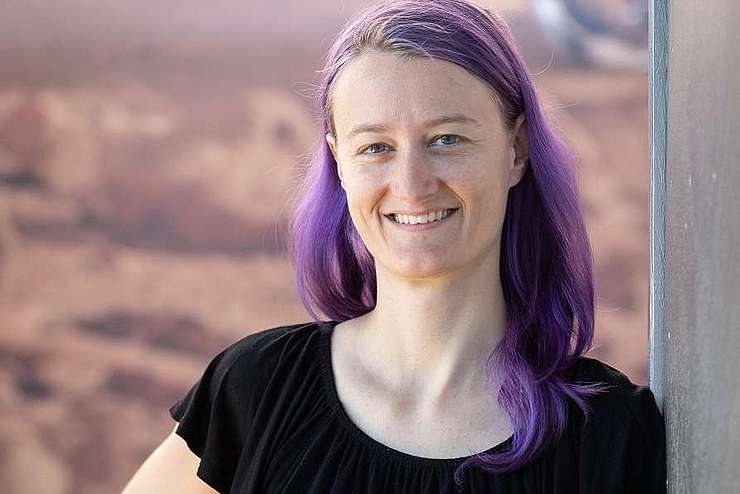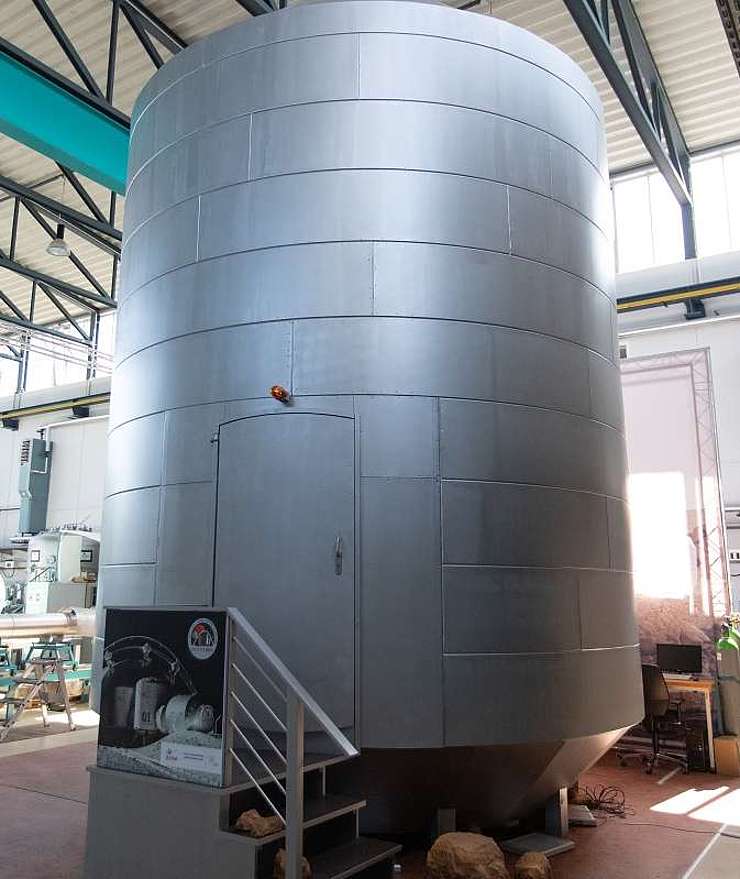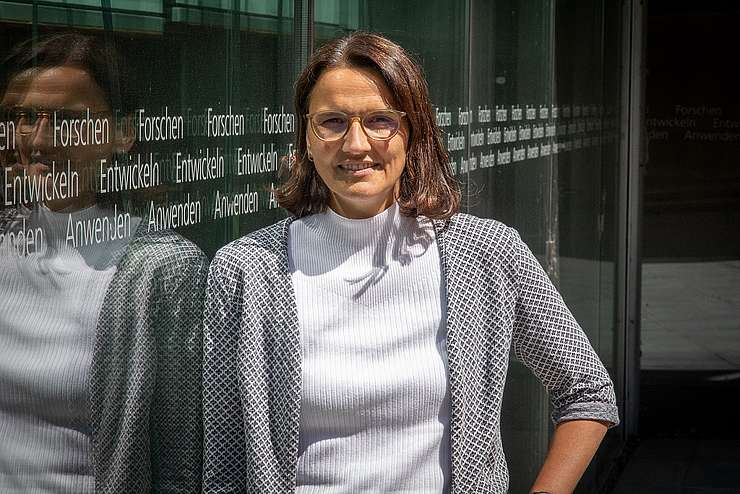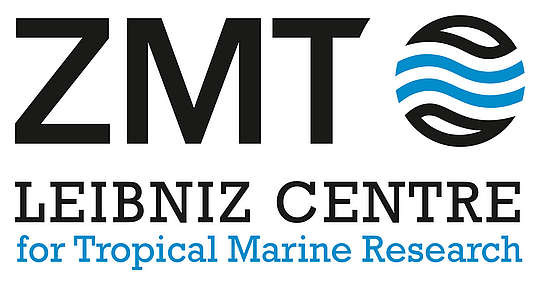Von Rainer Busch
04 Oct 2023

When designing housing modules that inhabitants can only briefly leave, it is helpful to have spent longer periods stuck indoors. Christiane Heinicke spent twelve months in 2016 in Hawaii on a Mars station developed by NASA with five other people. Contact with the outside world was rare; exchanging a message with the control station took 40 minutes, just like from Mars. When she was able to go outside, it was only in a spacesuit.
“Our goal is to develop a plan that can be implemented on Mars.”

The geophysicist, who now leads the development of a future Mars station, can draw from her experience in Hawaii. “The environment is unbelievably monotonous after a while, and your brain suffers from lack of stimulation,” the 37-year-old explained. “That is why the interior needs to have flexible forms and colors. From my own experience, I know how important both communal and retreat rooms are for a crew.”
The modular housing model, which was created in the Center of Applied Space Technology and Microgravity (ZARM) at the University of Bremen, where Heinicke works as a research assistant, shows how a dwelling could look. It is seven meters high, five meters in diameter, and has a cylindrical form, which is best at compensating for pressure differences. These differences are gigantic – the pressure on Mars is six millibars and in the station one bar. A metal encasing will help protect the six-person crew from the thin and toxic atmosphere, which consists of 95 percent carbon dioxide. These atmospheric conditions, combined with outside temperatures averaging minus 65 degrees Celsius, negate any need for windows.
Because a crew not only needs to work, eat, and sleep, but also relax and exercise, as well as a room for repairs, Heinicke is planning six modules. However, these are not going to take off to Mars. “Our goal is to develop a plan which can be implemented on Mars and tested here,” the researcher explained. This should enable sustainable survival and therefore the colonization of Mars. Or as Prof. Dr. Marc Avila, spokesperson for the “Humans on Mars – Pathway toward long-term sustainable exploration and settlement of Mars” initiative and director of ZARM, described it: “We want our research to show successful paths for a permanent human presence on Mars and provide long-term benefits for humanity while still taking care and being considerate of the red planet.”
A flight from Earth to Mars takes seven months; the first team could stay up to one and a half years before there would be a transfer window for the return flight. In the 2040s, such a mission may be possible. But how will the crew be supplied with water, energy, and food? Transportation capacities are limited, meaning on-site resources will need to be used as efficiently and sustainably as possible. A circular economy is the goal. “We need survival systems for the station which produce oxygen and bind carbon dioxide,” Heinicke said.
Researchers are also working on bioregenerative solutions. A team led by Dr. Cyprien Verseux and Prof. Dr. Sven Kerzenmacher has identified a suitable subspecies of cyanobacteria, a blue-green algae. When fed with dust and atmosphere from Mars, this microalga is capable of producing oxygen and creating a biomass that can be used to make food. In a second step, the team has already succeeded in growing duckweed, a nutrient-rich and fast-growing plant, which is fully edible. Others are also investigating how to extract metal from regolith, a dusty material on Mars’ surface, using microorganisms, carbon dioxide from the atmosphere, and solar energy.
“Sixty researchers from various faculties are involved in the ‘Humans on Mars’ initiative.”
Another important aspect is the communication between humans and machines. Robots and artificial intelligence will assist the crew on their long journey. These systems must be reliable, user-friendly, but most importantly, trustworthy. “What I find most exciting about ‘Humans on Mars’ is that it is more than just an engineering project,” Heinicke said. “We don’t just need reliable technologies, but ones that humans feel comfortable interacting with.”
Because of this, consultations with psychologists, behavioral experts, and philosophers were part of the housing module designing process. From the University of Bremen alone, 60 researchers from various faculties are involved in the initiative, which was launched by MAPEX – Center for Materials and Processes at the University of Bremen. Partners from the U Bremen Research Alliance are also contributing their expertise: the German Aerospace Center Bremen (DLR), Fraunhofer Institute for Manufacturing Technology and Advanced Materials (IFAM), Leibniz Institute for Materials Engineering (IWT), and German Research Center for Artificial Intelligence (DFKI).

Bremen State is funding the initiative, with seven projects in total. One of these is focused on materials for generating energy from atmospheric radiation. “We are researching the development of materials that protect against radiation and simultaneously convert it into energy,” Dr. Katharina Koschek, head of the department of Polymer Materials and Structures at Fraunhofer IFAM, said.
The radiation on Mars mostly consists of protons, similar to those used on Earth in radiation therapy to treat tumors. With new composite materials made of ceramic and polymers, this radiation could be used to generate energy. “Our vision is developing a very thin cell that can be used as a piece of clothing that produces energy while it protects the body,” Koschek told us.
“We are researching the development of materials that protect against radiation and simultaneously convert it into energy.”
Researchers at the University of Bremen and the German Aerospace Center (DLR) are also involved in the project to generate energy. Koschek, who returned to Bremen due to the appeal of applied research after completing her undergraduate and doctoral degrees, finds the cooperation of the research institutes to be one of the most rewarding aspects. Christiane Heinicke agrees. She moved to Bremen after her experience in Hawaii because she was offered the opportunity to create an extraterrestrial habitat in Bremen, and she appreciates the interaction between the different research areas.
The researchers agree that developing technologies for survival on Mars will help Earthlings, for example, in dealing with carbon dioxide. “We want to remove it from the atmosphere to use it as a raw material for plastic,” Koschek said. Extracting carbon dioxide in this manner also has a great potential for combating climate change. She hopes that the research will contribute to a more efficient use of resources such as water and energy, because resources that are scarce on Mars are often wasted on Earth.
A New Drop Tower for Bremen
Since 1990, the 146-meter drop tower of the Center of Applied Space Technology and Microgravity (ZARM) has been a highly visible symbol of the “City of Space,” highlighting Bremen’s research in weightlessness. In 2022, a comparatively small 16-meter research laboratory was added, which – in contrast to its larger counterpart – operates without a vacuum and therefore enables several hundreds of experiments to be performed each day. The GraviTower Bremen Prototype could be followed by another tower with a height of 120 to 130 meters.
The GraviTower is used to perform experiments with weightlessness and reduced gravity. This allows for examining material properties under the same conditions as the gravitational forces on Mars. These drop towers are not just interesting for the experiments in the “Humans on Mars” project, but for teams of researchers from around the world. ZARM director Prof. Dr. Marc Avila is convinced that a large GraviTower will magnify the impact of research in the natural sciences emanating from Bremen.
Further information about the drop tower is available on the ZARM website













